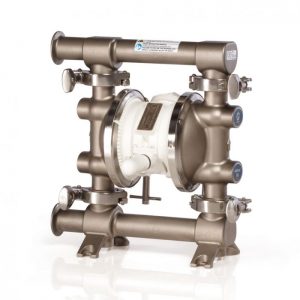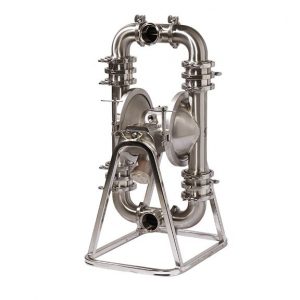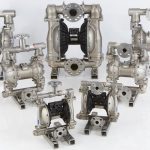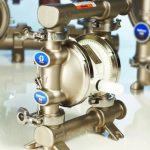Indústrias que operam no processamento de alimentos precisam de recursos seguros e higiênicos. A manipulação incorreta pode causar contaminação, e por consequência, problemas muito sérios para a empresa. Dessa forma, a preocupação com a higiene deve ser uma prioridade para esse tipo de operação, fazendo da bomba pneumática de diafragma um equipamento essencial.
Indústrias que processam alimentos precisam:
• Lidar com diferentes tipos de materiais, de baixa a alta viscosidade
• Realizar o carregamento, descarregamento e transporte
• Manusear líquidos e fluidos com uma ampla faixa de temperaturas;
• Ensuring that there is hygiene in the process and protection against contamination
• Ensuring routine cleaning/sanitization
• Atender às diretrizes dos órgãos regulamentadores.
Here are some examples of sanitary pumps:
DOUBLE DIAPHRAGM PUMP SANIFORCE 3150 HS – GRACO
DOUBLE DIAPHRAGM PUMP SANIFORCE 1040 - GRACO
In this sense, pneumatic diaphragm pumps for sanitary applications are the best option for this type of operation. Because they are highly versatile, they can guarantee several advantages for the company, such as:
• Are shear sensitive: The pump ensures a gentle pumping action on the product being pumped.
• Capable of handling solids: allows solids to pass through without damaging the pump or the product.
• Are self-priming: Unlike other pumping technologies, pneumatic diaphragm pumps are self-priming and do not require positive inlet pressure to prime.
• Can run dry: The pump is not damaged if it runs dry. It is very common for pumps to run dry, especially towards the end of a transfer.
• Easy to clean/sanitize: The pumps are simple to disassemble and clean.
• Meet Required Certification Levels: Built to meet the rigorous needs of the industries they serve.
• Are Grounded for Safety: Pneumatic pumps are groundable and require no electricity to operate, ensuring safe handling of hazardous fluids.
• They are portable: they can be easily moved and require only compressed air to operate.
• Can handle a wide range of viscosities, pressures and flows: With flows up to 234 gpm (886 lpm), the pumps can handle pressures up to 125 psi (8.6 bar) and virtually any fluid that can flow up to 90,000 cst (415,500 ssu).
• Have a low initial purchase price: In most cases, pumps cost significantly less than other positive displacement pumps.
Enjoy and check out our article on the differences between FDA compliant pumps and sanitary pumps:
How to choose between a hygienic pump and an FDA pump?
To ensure cleanliness and disinfection, most pneumatic diaphragm pumps are disassembled at the end of each shift and cleaned/disinfected. Therefore, it is very important to know the characteristics and capabilities of each type of pump, as we will see below:
FDA PUMPS:
• Features a highly polished 150 micro-inch surface finish;
• Must be disassembled for cleaning;
• For draining, they need to be turned over manually.

HYGIENIC PUMPS:
• Features a highly polished 32 micro-inch surface finish;
• Offer a rotating support for drainage;
• Are third-party certified and tested.
When choosing the ideal pump for your application, it is important to consider the following aspects:
• What certification levels (if any) are required for your operation?
• What product will be pumped?
• How will the cleaning be done?
• What is the available budget?

The safety of pneumatic diaphragm pumps
Depending on the application type or food to be pumped, a hygienic pump or an FDA pump may not be required. Below are some applications that allow the use of a standard pneumatic diaphragm pump:
• Sanitization chemicals – Sanitizing chemicals are widely used in food processing plants to reduce the presence of bacteria and other microorganisms. These chemicals are used to wash floors and tables, among other surfaces and applications, allowing the use of small ¼”, ½” and 1” plastic pumps. They are commonly applied in dairy and meat processing industries for sanitization.
• Sump Pumps – Pneumatic diaphragm pumps are the best choice for sump pumps in food plants as they can handle a wide range of fluids, can run dry, and can handle solids.










